Analysis of Trust and Confidence in Central Banks for Monetary Policy
VerifiedAdded on 2023/05/30
|34
|9081
|329
Report
AI Summary
This report critically examines the crucial role of trust and confidence in central banks for the effectiveness of monetary policy. It highlights the central bank's responsibility in maintaining financial market stability, controlling interest rates, and managing inflation. The report investigates the impact of the financial crisis and non-standard monetary policy tools, such as quantitative easing, on the level of trust in the European Central Bank (ECB). It explores the ECB's objectives, the measures it implemented, and the justifications behind its actions, analyzing the effects of these policies on market players within the Euro Zone. The research utilizes scholarly articles and academic writings to analyze the ECB's monetary policy, focusing on the impact of the financial crisis and non-standard monetary policy tools on the level of trust in the ECB. The report also examines the importance of central bank transparency and public acceptance of monetary tools, emphasizing the need for effective monetary policy to maintain financial stability and promote economic growth.
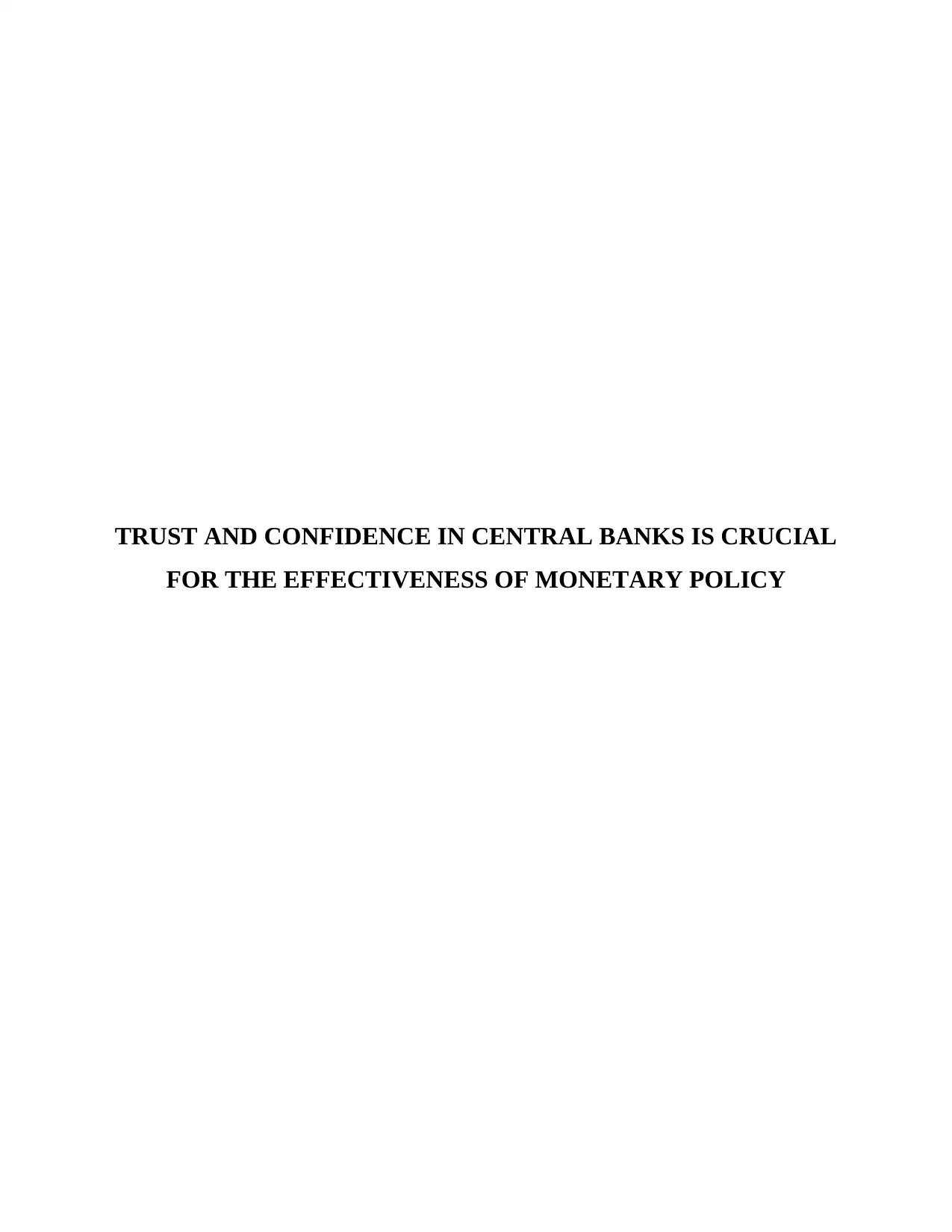
TRUST AND CONFIDENCE IN CENTRAL BANKS IS CRUCIAL
FOR THE EFFECTIVENESS OF MONETARY POLICY
FOR THE EFFECTIVENESS OF MONETARY POLICY
Paraphrase This Document
Need a fresh take? Get an instant paraphrase of this document with our AI Paraphraser
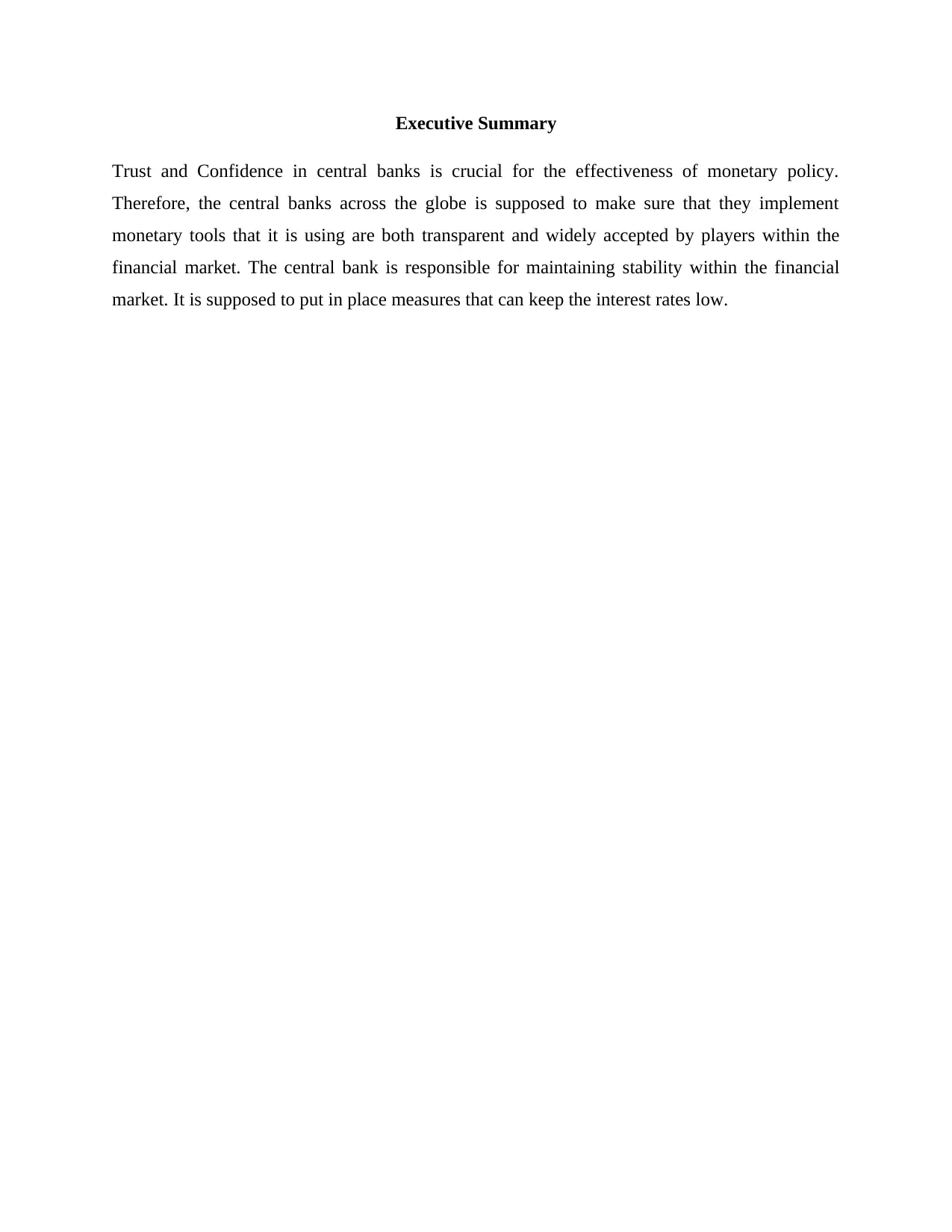
Executive Summary
Trust and Confidence in central banks is crucial for the effectiveness of monetary policy.
Therefore, the central banks across the globe is supposed to make sure that they implement
monetary tools that it is using are both transparent and widely accepted by players within the
financial market. The central bank is responsible for maintaining stability within the financial
market. It is supposed to put in place measures that can keep the interest rates low.
Trust and Confidence in central banks is crucial for the effectiveness of monetary policy.
Therefore, the central banks across the globe is supposed to make sure that they implement
monetary tools that it is using are both transparent and widely accepted by players within the
financial market. The central bank is responsible for maintaining stability within the financial
market. It is supposed to put in place measures that can keep the interest rates low.

Acknowledgement
There are many people that have earned my gratitude for their contribution to my time in
graduate school. More specifically, I would like to thank five groups of people, without whom
this thesis would not have been possible: my thesis committee members, my lab mates, my
industrial collaborators, funding agencies, and my family.
There are many people that have earned my gratitude for their contribution to my time in
graduate school. More specifically, I would like to thank five groups of people, without whom
this thesis would not have been possible: my thesis committee members, my lab mates, my
industrial collaborators, funding agencies, and my family.
⊘ This is a preview!⊘
Do you want full access?
Subscribe today to unlock all pages.

Trusted by 1+ million students worldwide
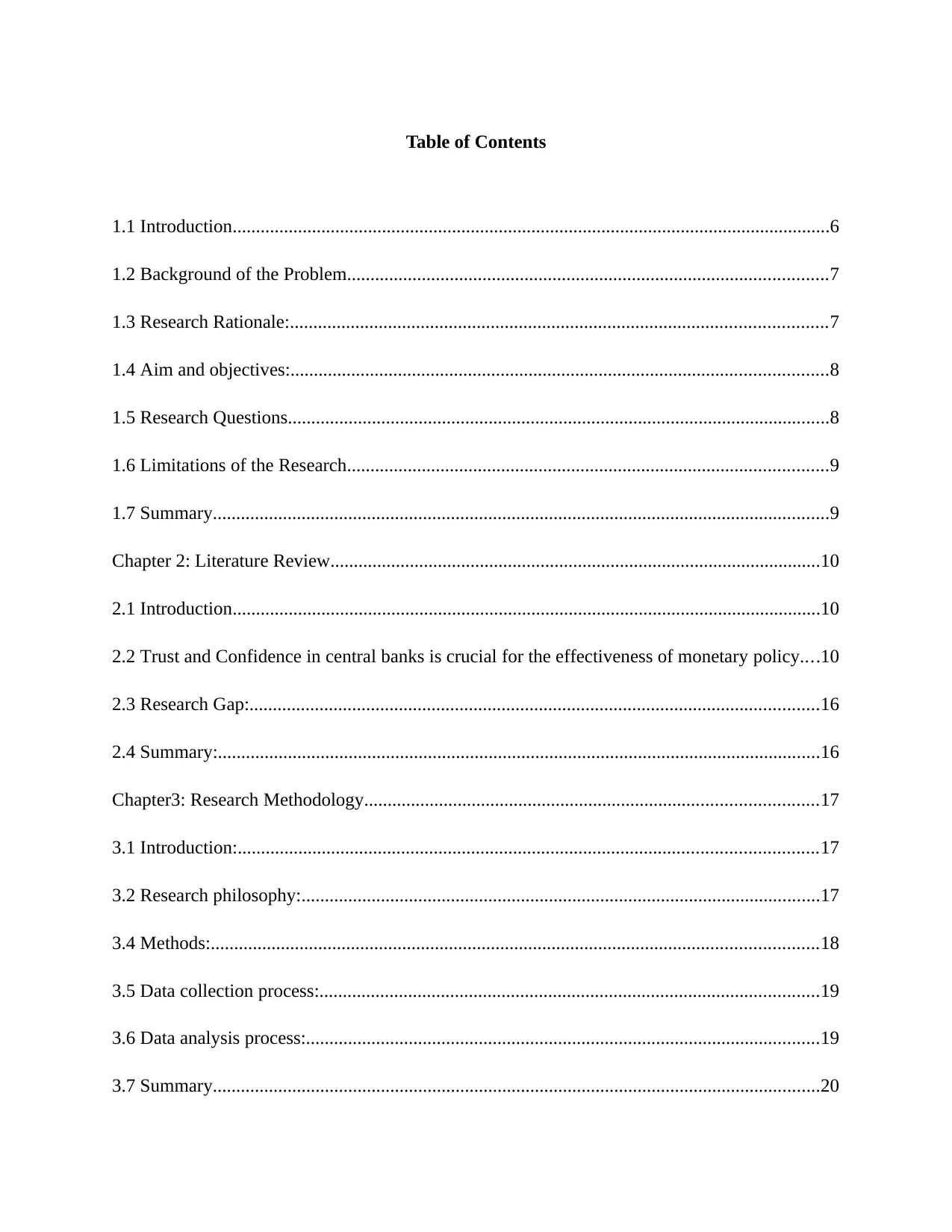
Table of Contents
1.1 Introduction................................................................................................................................6
1.2 Background of the Problem.......................................................................................................7
1.3 Research Rationale:...................................................................................................................7
1.4 Aim and objectives:...................................................................................................................8
1.5 Research Questions....................................................................................................................8
1.6 Limitations of the Research.......................................................................................................9
1.7 Summary....................................................................................................................................9
Chapter 2: Literature Review.........................................................................................................10
2.1 Introduction..............................................................................................................................10
2.2 Trust and Confidence in central banks is crucial for the effectiveness of monetary policy....10
2.3 Research Gap:..........................................................................................................................16
2.4 Summary:.................................................................................................................................16
Chapter3: Research Methodology.................................................................................................17
3.1 Introduction:............................................................................................................................17
3.2 Research philosophy:...............................................................................................................17
3.4 Methods:..................................................................................................................................18
3.5 Data collection process:...........................................................................................................19
3.6 Data analysis process:..............................................................................................................19
3.7 Summary..................................................................................................................................20
1.1 Introduction................................................................................................................................6
1.2 Background of the Problem.......................................................................................................7
1.3 Research Rationale:...................................................................................................................7
1.4 Aim and objectives:...................................................................................................................8
1.5 Research Questions....................................................................................................................8
1.6 Limitations of the Research.......................................................................................................9
1.7 Summary....................................................................................................................................9
Chapter 2: Literature Review.........................................................................................................10
2.1 Introduction..............................................................................................................................10
2.2 Trust and Confidence in central banks is crucial for the effectiveness of monetary policy....10
2.3 Research Gap:..........................................................................................................................16
2.4 Summary:.................................................................................................................................16
Chapter3: Research Methodology.................................................................................................17
3.1 Introduction:............................................................................................................................17
3.2 Research philosophy:...............................................................................................................17
3.4 Methods:..................................................................................................................................18
3.5 Data collection process:...........................................................................................................19
3.6 Data analysis process:..............................................................................................................19
3.7 Summary..................................................................................................................................20
Paraphrase This Document
Need a fresh take? Get an instant paraphrase of this document with our AI Paraphraser
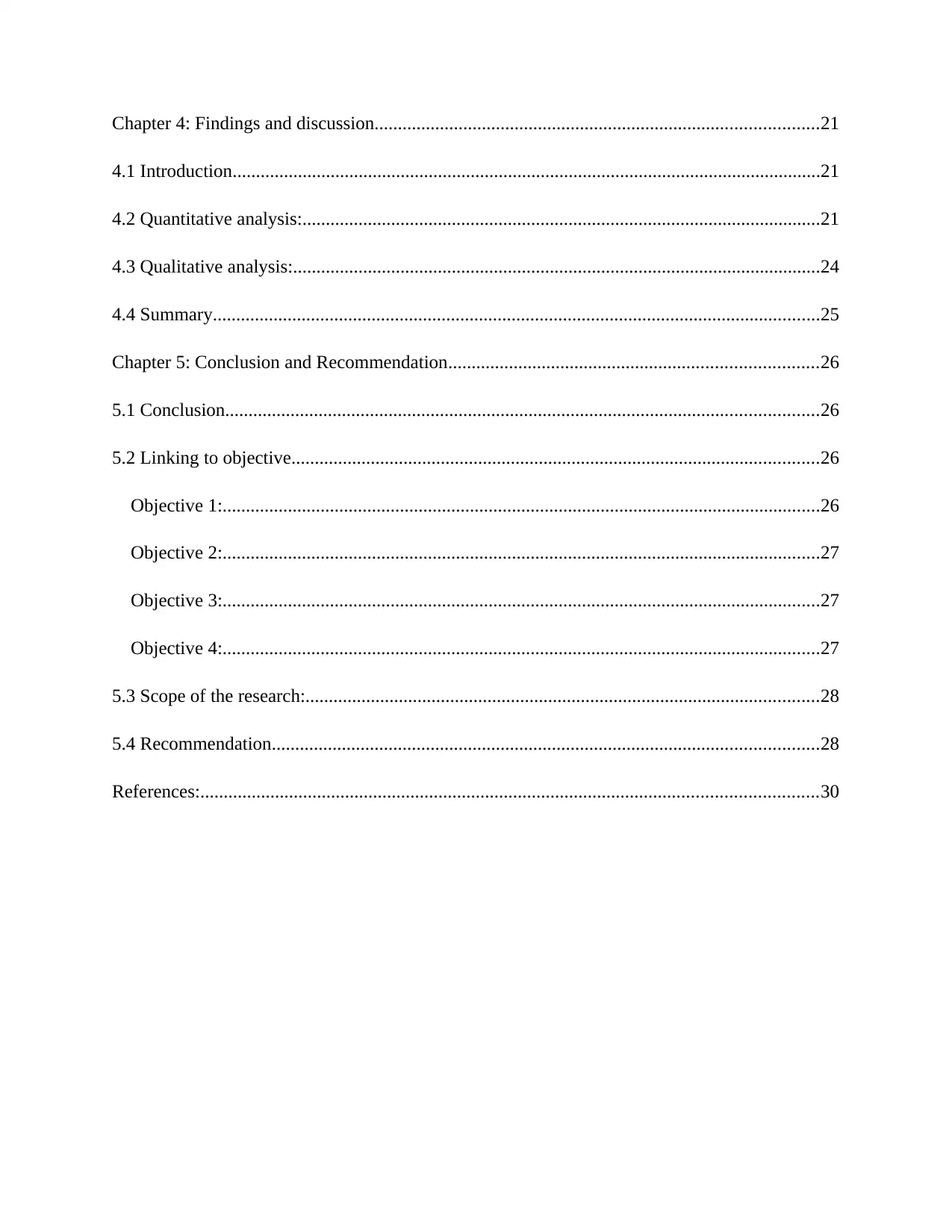
Chapter 4: Findings and discussion...............................................................................................21
4.1 Introduction..............................................................................................................................21
4.2 Quantitative analysis:...............................................................................................................21
4.3 Qualitative analysis:.................................................................................................................24
4.4 Summary..................................................................................................................................25
Chapter 5: Conclusion and Recommendation...............................................................................26
5.1 Conclusion...............................................................................................................................26
5.2 Linking to objective.................................................................................................................26
Objective 1:................................................................................................................................26
Objective 2:................................................................................................................................27
Objective 3:................................................................................................................................27
Objective 4:................................................................................................................................27
5.3 Scope of the research:..............................................................................................................28
5.4 Recommendation.....................................................................................................................28
References:....................................................................................................................................30
4.1 Introduction..............................................................................................................................21
4.2 Quantitative analysis:...............................................................................................................21
4.3 Qualitative analysis:.................................................................................................................24
4.4 Summary..................................................................................................................................25
Chapter 5: Conclusion and Recommendation...............................................................................26
5.1 Conclusion...............................................................................................................................26
5.2 Linking to objective.................................................................................................................26
Objective 1:................................................................................................................................26
Objective 2:................................................................................................................................27
Objective 3:................................................................................................................................27
Objective 4:................................................................................................................................27
5.3 Scope of the research:..............................................................................................................28
5.4 Recommendation.....................................................................................................................28
References:....................................................................................................................................30
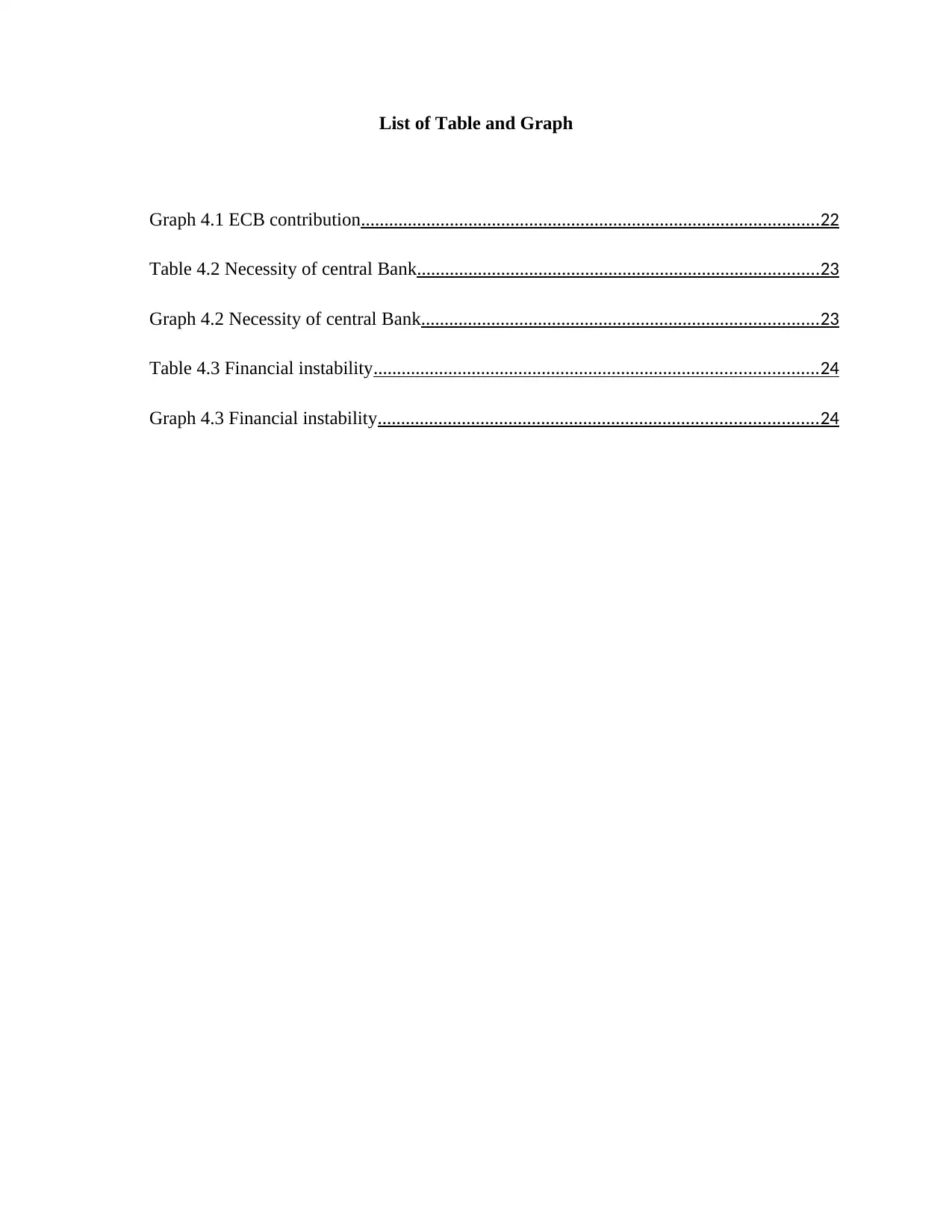
List of Table and Graph
Graph 4.1 ECB contribution..................................................................................................22
Table 4.2 Necessity of central Bank......................................................................................23
Graph 4.2 Necessity of central Bank.....................................................................................23
Table 4.3 Financial instability...............................................................................................24
Graph 4.3 Financial instability..............................................................................................24
Graph 4.1 ECB contribution..................................................................................................22
Table 4.2 Necessity of central Bank......................................................................................23
Graph 4.2 Necessity of central Bank.....................................................................................23
Table 4.3 Financial instability...............................................................................................24
Graph 4.3 Financial instability..............................................................................................24
⊘ This is a preview!⊘
Do you want full access?
Subscribe today to unlock all pages.

Trusted by 1+ million students worldwide
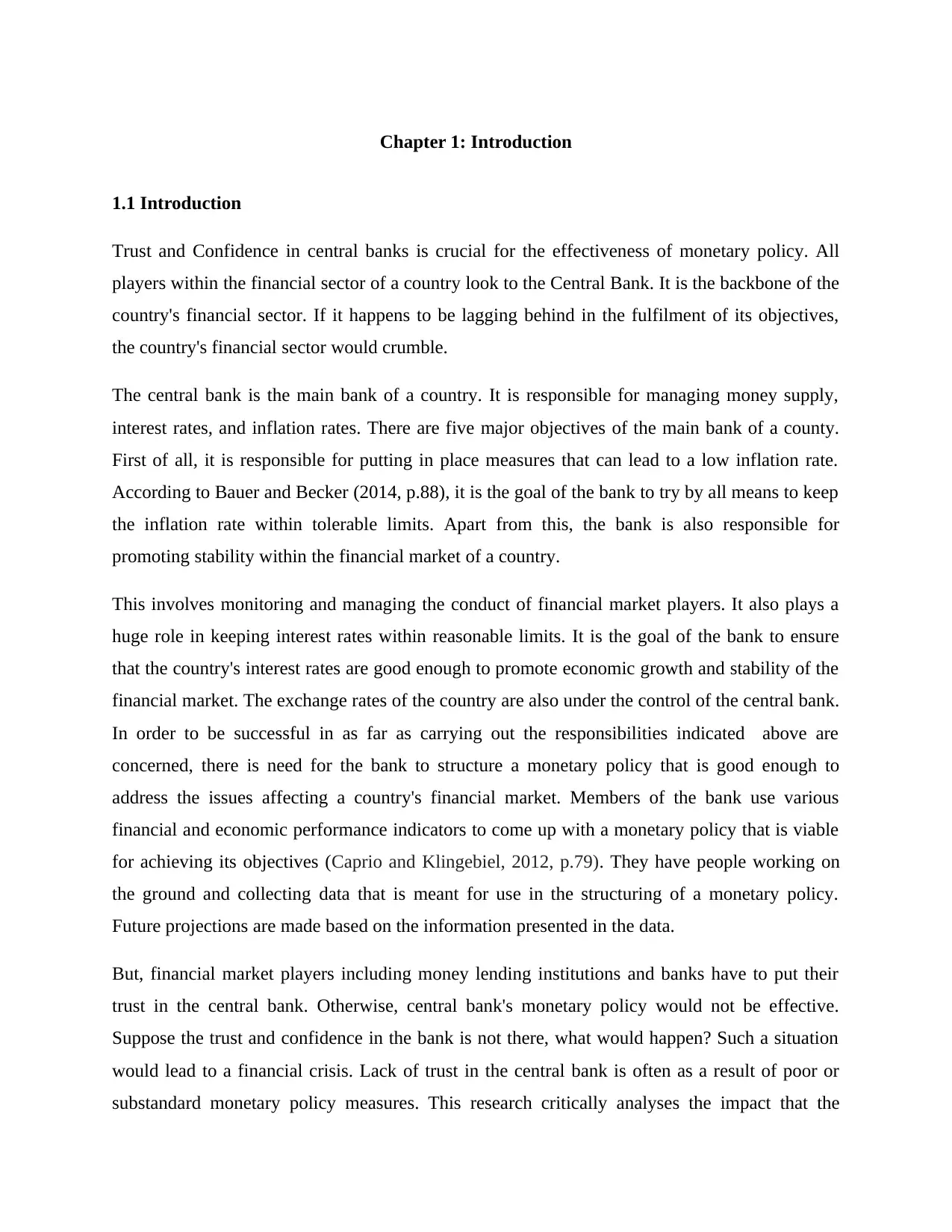
Chapter 1: Introduction
1.1 Introduction
Trust and Confidence in central banks is crucial for the effectiveness of monetary policy. All
players within the financial sector of a country look to the Central Bank. It is the backbone of the
country's financial sector. If it happens to be lagging behind in the fulfilment of its objectives,
the country's financial sector would crumble.
The central bank is the main bank of a country. It is responsible for managing money supply,
interest rates, and inflation rates. There are five major objectives of the main bank of a county.
First of all, it is responsible for putting in place measures that can lead to a low inflation rate.
According to Bauer and Becker (2014, p.88), it is the goal of the bank to try by all means to keep
the inflation rate within tolerable limits. Apart from this, the bank is also responsible for
promoting stability within the financial market of a country.
This involves monitoring and managing the conduct of financial market players. It also plays a
huge role in keeping interest rates within reasonable limits. It is the goal of the bank to ensure
that the country's interest rates are good enough to promote economic growth and stability of the
financial market. The exchange rates of the country are also under the control of the central bank.
In order to be successful in as far as carrying out the responsibilities indicated above are
concerned, there is need for the bank to structure a monetary policy that is good enough to
address the issues affecting a country's financial market. Members of the bank use various
financial and economic performance indicators to come up with a monetary policy that is viable
for achieving its objectives (Caprio and Klingebiel, 2012, p.79). They have people working on
the ground and collecting data that is meant for use in the structuring of a monetary policy.
Future projections are made based on the information presented in the data.
But, financial market players including money lending institutions and banks have to put their
trust in the central bank. Otherwise, central bank's monetary policy would not be effective.
Suppose the trust and confidence in the bank is not there, what would happen? Such a situation
would lead to a financial crisis. Lack of trust in the central bank is often as a result of poor or
substandard monetary policy measures. This research critically analyses the impact that the
1.1 Introduction
Trust and Confidence in central banks is crucial for the effectiveness of monetary policy. All
players within the financial sector of a country look to the Central Bank. It is the backbone of the
country's financial sector. If it happens to be lagging behind in the fulfilment of its objectives,
the country's financial sector would crumble.
The central bank is the main bank of a country. It is responsible for managing money supply,
interest rates, and inflation rates. There are five major objectives of the main bank of a county.
First of all, it is responsible for putting in place measures that can lead to a low inflation rate.
According to Bauer and Becker (2014, p.88), it is the goal of the bank to try by all means to keep
the inflation rate within tolerable limits. Apart from this, the bank is also responsible for
promoting stability within the financial market of a country.
This involves monitoring and managing the conduct of financial market players. It also plays a
huge role in keeping interest rates within reasonable limits. It is the goal of the bank to ensure
that the country's interest rates are good enough to promote economic growth and stability of the
financial market. The exchange rates of the country are also under the control of the central bank.
In order to be successful in as far as carrying out the responsibilities indicated above are
concerned, there is need for the bank to structure a monetary policy that is good enough to
address the issues affecting a country's financial market. Members of the bank use various
financial and economic performance indicators to come up with a monetary policy that is viable
for achieving its objectives (Caprio and Klingebiel, 2012, p.79). They have people working on
the ground and collecting data that is meant for use in the structuring of a monetary policy.
Future projections are made based on the information presented in the data.
But, financial market players including money lending institutions and banks have to put their
trust in the central bank. Otherwise, central bank's monetary policy would not be effective.
Suppose the trust and confidence in the bank is not there, what would happen? Such a situation
would lead to a financial crisis. Lack of trust in the central bank is often as a result of poor or
substandard monetary policy measures. This research critically analyses the impact that the
Paraphrase This Document
Need a fresh take? Get an instant paraphrase of this document with our AI Paraphraser
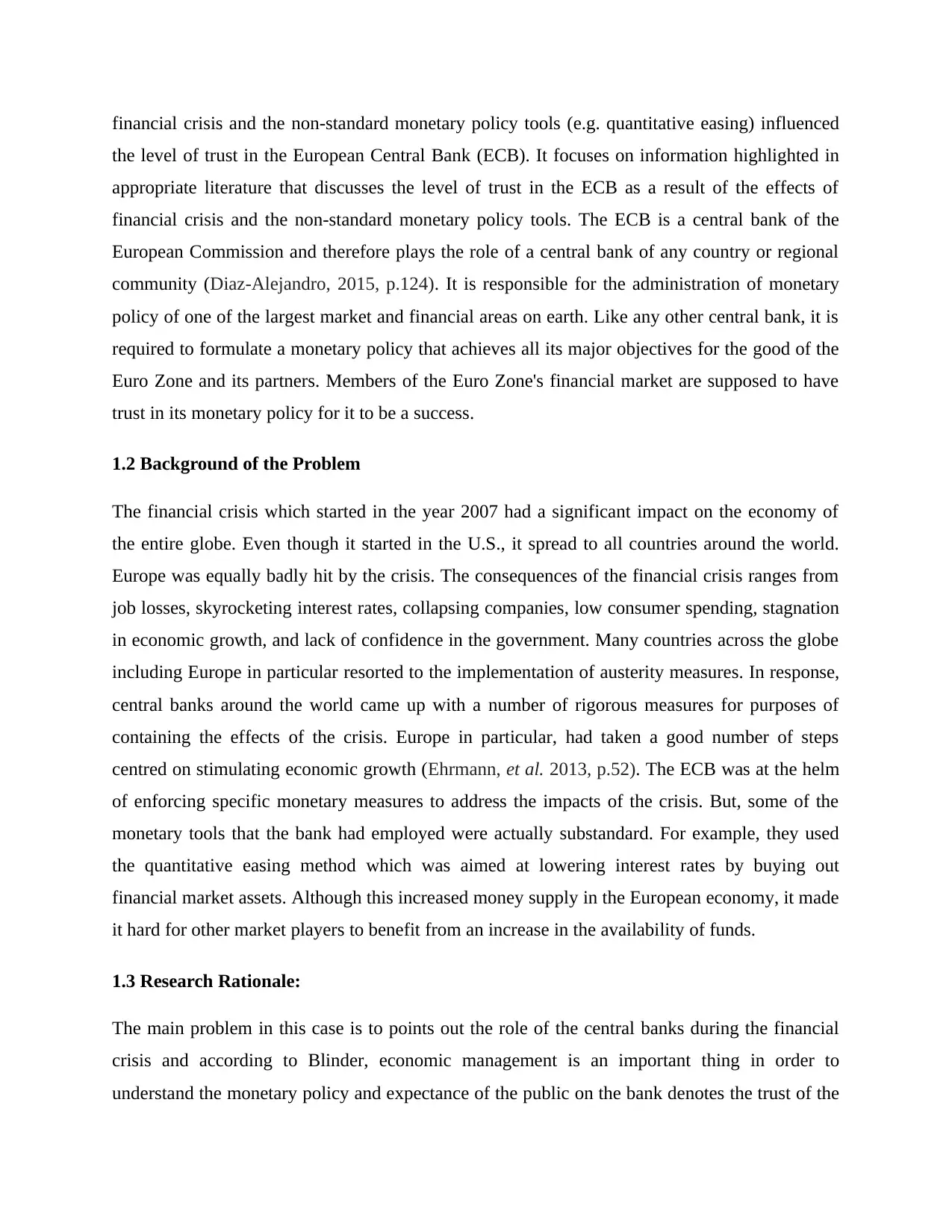
financial crisis and the non-standard monetary policy tools (e.g. quantitative easing) influenced
the level of trust in the European Central Bank (ECB). It focuses on information highlighted in
appropriate literature that discusses the level of trust in the ECB as a result of the effects of
financial crisis and the non-standard monetary policy tools. The ECB is a central bank of the
European Commission and therefore plays the role of a central bank of any country or regional
community (Diaz-Alejandro, 2015, p.124). It is responsible for the administration of monetary
policy of one of the largest market and financial areas on earth. Like any other central bank, it is
required to formulate a monetary policy that achieves all its major objectives for the good of the
Euro Zone and its partners. Members of the Euro Zone's financial market are supposed to have
trust in its monetary policy for it to be a success.
1.2 Background of the Problem
The financial crisis which started in the year 2007 had a significant impact on the economy of
the entire globe. Even though it started in the U.S., it spread to all countries around the world.
Europe was equally badly hit by the crisis. The consequences of the financial crisis ranges from
job losses, skyrocketing interest rates, collapsing companies, low consumer spending, stagnation
in economic growth, and lack of confidence in the government. Many countries across the globe
including Europe in particular resorted to the implementation of austerity measures. In response,
central banks around the world came up with a number of rigorous measures for purposes of
containing the effects of the crisis. Europe in particular, had taken a good number of steps
centred on stimulating economic growth (Ehrmann, et al. 2013, p.52). The ECB was at the helm
of enforcing specific monetary measures to address the impacts of the crisis. But, some of the
monetary tools that the bank had employed were actually substandard. For example, they used
the quantitative easing method which was aimed at lowering interest rates by buying out
financial market assets. Although this increased money supply in the European economy, it made
it hard for other market players to benefit from an increase in the availability of funds.
1.3 Research Rationale:
The main problem in this case is to points out the role of the central banks during the financial
crisis and according to Blinder, economic management is an important thing in order to
understand the monetary policy and expectance of the public on the bank denotes the trust of the
the level of trust in the European Central Bank (ECB). It focuses on information highlighted in
appropriate literature that discusses the level of trust in the ECB as a result of the effects of
financial crisis and the non-standard monetary policy tools. The ECB is a central bank of the
European Commission and therefore plays the role of a central bank of any country or regional
community (Diaz-Alejandro, 2015, p.124). It is responsible for the administration of monetary
policy of one of the largest market and financial areas on earth. Like any other central bank, it is
required to formulate a monetary policy that achieves all its major objectives for the good of the
Euro Zone and its partners. Members of the Euro Zone's financial market are supposed to have
trust in its monetary policy for it to be a success.
1.2 Background of the Problem
The financial crisis which started in the year 2007 had a significant impact on the economy of
the entire globe. Even though it started in the U.S., it spread to all countries around the world.
Europe was equally badly hit by the crisis. The consequences of the financial crisis ranges from
job losses, skyrocketing interest rates, collapsing companies, low consumer spending, stagnation
in economic growth, and lack of confidence in the government. Many countries across the globe
including Europe in particular resorted to the implementation of austerity measures. In response,
central banks around the world came up with a number of rigorous measures for purposes of
containing the effects of the crisis. Europe in particular, had taken a good number of steps
centred on stimulating economic growth (Ehrmann, et al. 2013, p.52). The ECB was at the helm
of enforcing specific monetary measures to address the impacts of the crisis. But, some of the
monetary tools that the bank had employed were actually substandard. For example, they used
the quantitative easing method which was aimed at lowering interest rates by buying out
financial market assets. Although this increased money supply in the European economy, it made
it hard for other market players to benefit from an increase in the availability of funds.
1.3 Research Rationale:
The main problem in this case is to points out the role of the central banks during the financial
crisis and according to Blinder, economic management is an important thing in order to
understand the monetary policy and expectance of the public on the bank denotes the trust of the
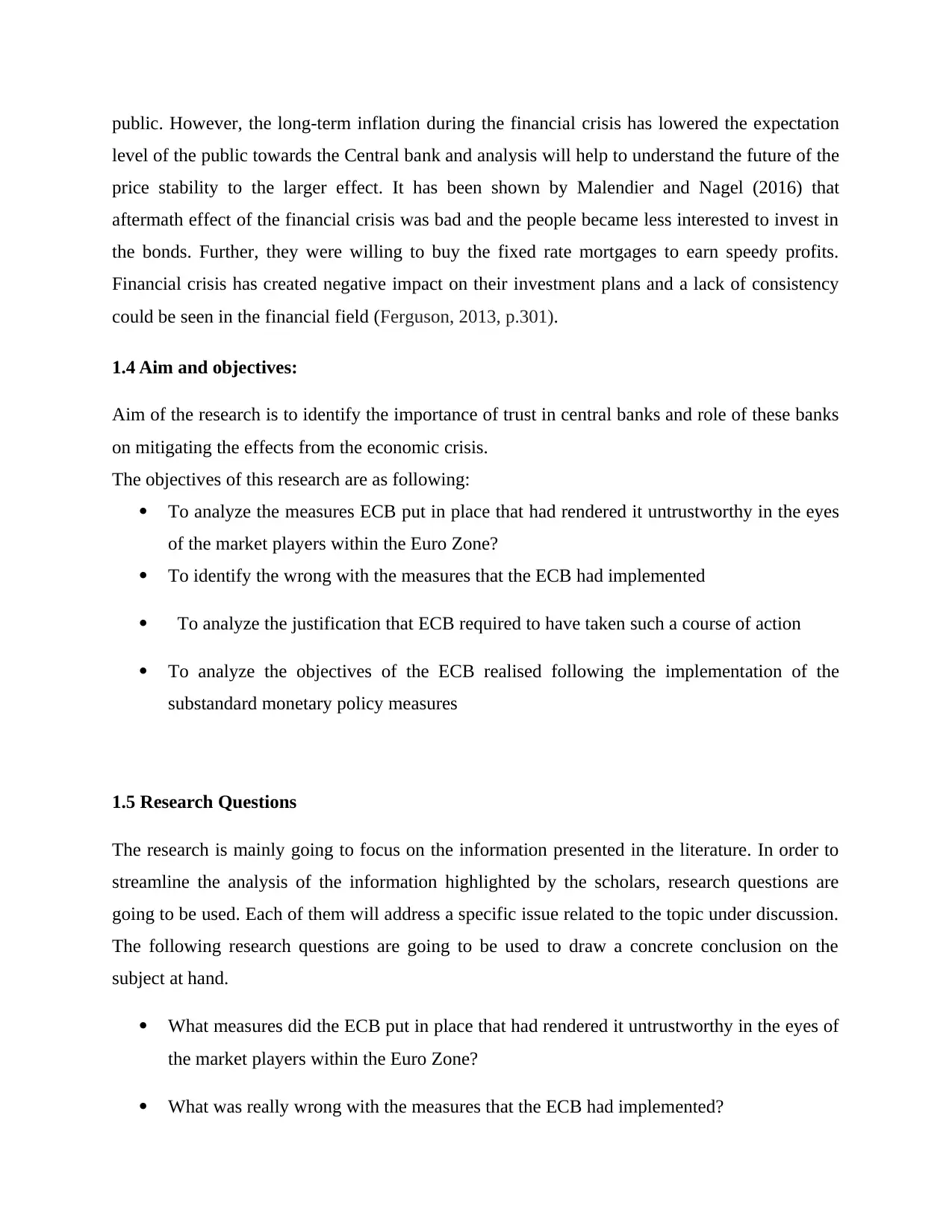
public. However, the long-term inflation during the financial crisis has lowered the expectation
level of the public towards the Central bank and analysis will help to understand the future of the
price stability to the larger effect. It has been shown by Malendier and Nagel (2016) that
aftermath effect of the financial crisis was bad and the people became less interested to invest in
the bonds. Further, they were willing to buy the fixed rate mortgages to earn speedy profits.
Financial crisis has created negative impact on their investment plans and a lack of consistency
could be seen in the financial field (Ferguson, 2013, p.301).
1.4 Aim and objectives:
Aim of the research is to identify the importance of trust in central banks and role of these banks
on mitigating the effects from the economic crisis.
The objectives of this research are as following:
To analyze the measures ECB put in place that had rendered it untrustworthy in the eyes
of the market players within the Euro Zone?
To identify the wrong with the measures that the ECB had implemented
To analyze the justification that ECB required to have taken such a course of action
To analyze the objectives of the ECB realised following the implementation of the
substandard monetary policy measures
1.5 Research Questions
The research is mainly going to focus on the information presented in the literature. In order to
streamline the analysis of the information highlighted by the scholars, research questions are
going to be used. Each of them will address a specific issue related to the topic under discussion.
The following research questions are going to be used to draw a concrete conclusion on the
subject at hand.
What measures did the ECB put in place that had rendered it untrustworthy in the eyes of
the market players within the Euro Zone?
What was really wrong with the measures that the ECB had implemented?
level of the public towards the Central bank and analysis will help to understand the future of the
price stability to the larger effect. It has been shown by Malendier and Nagel (2016) that
aftermath effect of the financial crisis was bad and the people became less interested to invest in
the bonds. Further, they were willing to buy the fixed rate mortgages to earn speedy profits.
Financial crisis has created negative impact on their investment plans and a lack of consistency
could be seen in the financial field (Ferguson, 2013, p.301).
1.4 Aim and objectives:
Aim of the research is to identify the importance of trust in central banks and role of these banks
on mitigating the effects from the economic crisis.
The objectives of this research are as following:
To analyze the measures ECB put in place that had rendered it untrustworthy in the eyes
of the market players within the Euro Zone?
To identify the wrong with the measures that the ECB had implemented
To analyze the justification that ECB required to have taken such a course of action
To analyze the objectives of the ECB realised following the implementation of the
substandard monetary policy measures
1.5 Research Questions
The research is mainly going to focus on the information presented in the literature. In order to
streamline the analysis of the information highlighted by the scholars, research questions are
going to be used. Each of them will address a specific issue related to the topic under discussion.
The following research questions are going to be used to draw a concrete conclusion on the
subject at hand.
What measures did the ECB put in place that had rendered it untrustworthy in the eyes of
the market players within the Euro Zone?
What was really wrong with the measures that the ECB had implemented?
⊘ This is a preview!⊘
Do you want full access?
Subscribe today to unlock all pages.

Trusted by 1+ million students worldwide
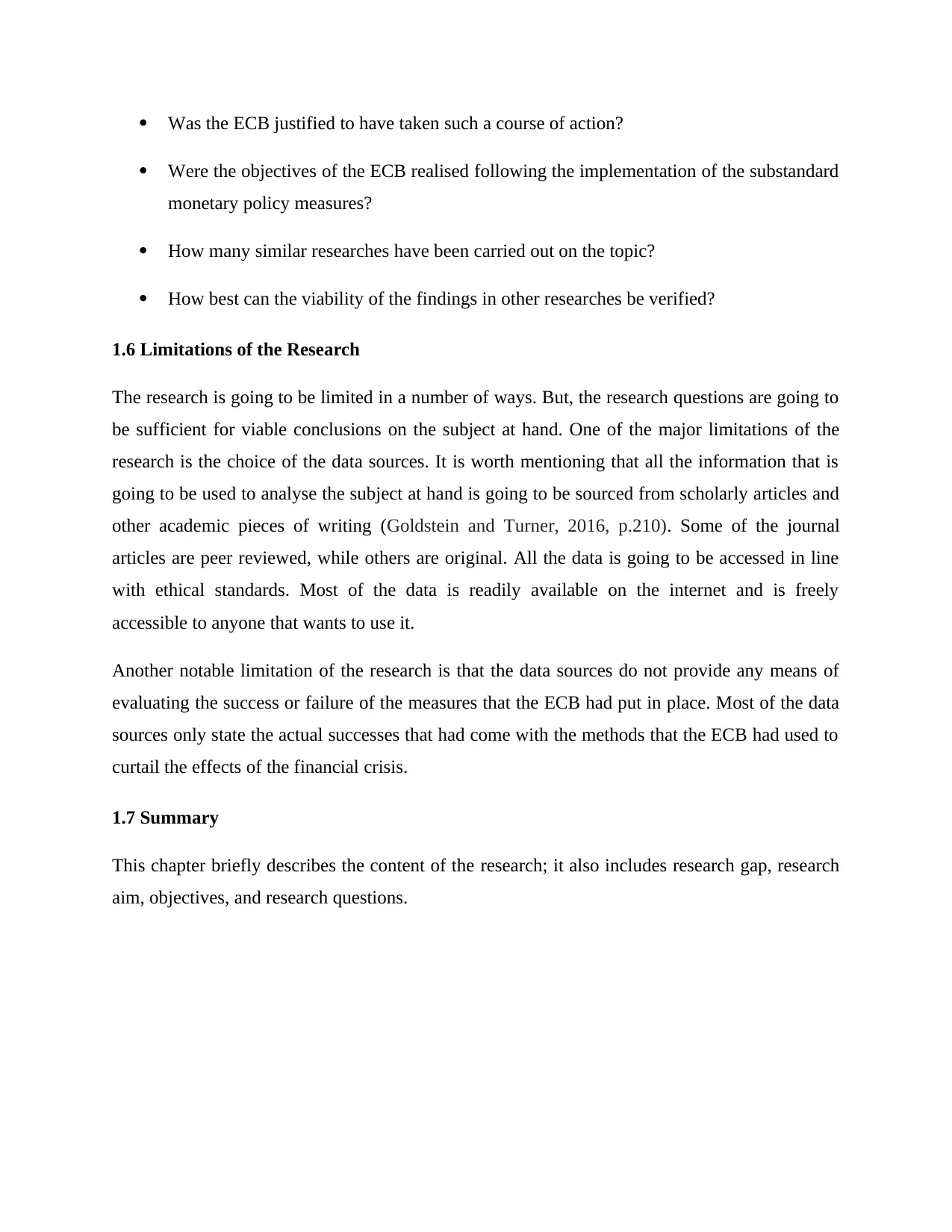
Was the ECB justified to have taken such a course of action?
Were the objectives of the ECB realised following the implementation of the substandard
monetary policy measures?
How many similar researches have been carried out on the topic?
How best can the viability of the findings in other researches be verified?
1.6 Limitations of the Research
The research is going to be limited in a number of ways. But, the research questions are going to
be sufficient for viable conclusions on the subject at hand. One of the major limitations of the
research is the choice of the data sources. It is worth mentioning that all the information that is
going to be used to analyse the subject at hand is going to be sourced from scholarly articles and
other academic pieces of writing (Goldstein and Turner, 2016, p.210). Some of the journal
articles are peer reviewed, while others are original. All the data is going to be accessed in line
with ethical standards. Most of the data is readily available on the internet and is freely
accessible to anyone that wants to use it.
Another notable limitation of the research is that the data sources do not provide any means of
evaluating the success or failure of the measures that the ECB had put in place. Most of the data
sources only state the actual successes that had come with the methods that the ECB had used to
curtail the effects of the financial crisis.
1.7 Summary
This chapter briefly describes the content of the research; it also includes research gap, research
aim, objectives, and research questions.
Were the objectives of the ECB realised following the implementation of the substandard
monetary policy measures?
How many similar researches have been carried out on the topic?
How best can the viability of the findings in other researches be verified?
1.6 Limitations of the Research
The research is going to be limited in a number of ways. But, the research questions are going to
be sufficient for viable conclusions on the subject at hand. One of the major limitations of the
research is the choice of the data sources. It is worth mentioning that all the information that is
going to be used to analyse the subject at hand is going to be sourced from scholarly articles and
other academic pieces of writing (Goldstein and Turner, 2016, p.210). Some of the journal
articles are peer reviewed, while others are original. All the data is going to be accessed in line
with ethical standards. Most of the data is readily available on the internet and is freely
accessible to anyone that wants to use it.
Another notable limitation of the research is that the data sources do not provide any means of
evaluating the success or failure of the measures that the ECB had put in place. Most of the data
sources only state the actual successes that had come with the methods that the ECB had used to
curtail the effects of the financial crisis.
1.7 Summary
This chapter briefly describes the content of the research; it also includes research gap, research
aim, objectives, and research questions.
Paraphrase This Document
Need a fresh take? Get an instant paraphrase of this document with our AI Paraphraser
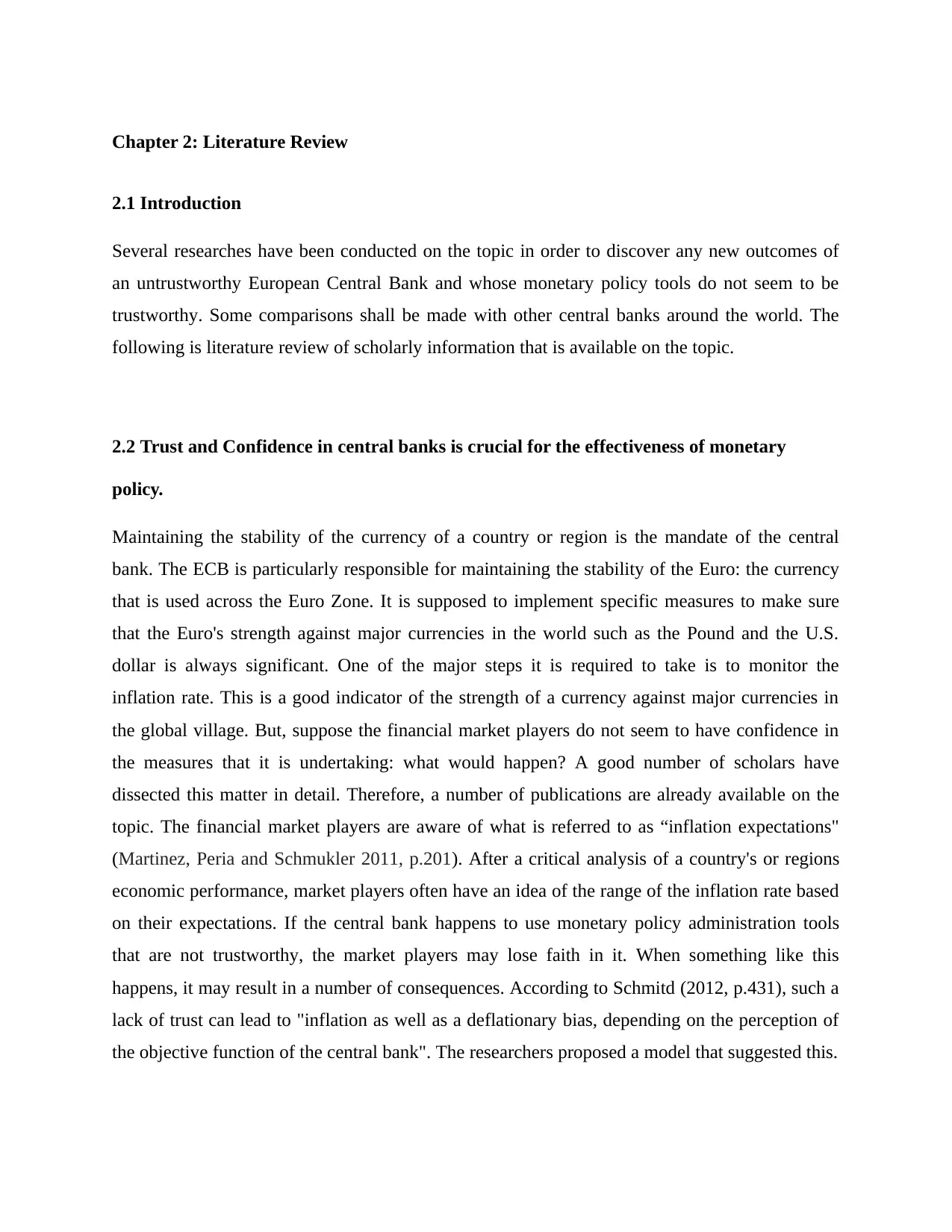
Chapter 2: Literature Review
2.1 Introduction
Several researches have been conducted on the topic in order to discover any new outcomes of
an untrustworthy European Central Bank and whose monetary policy tools do not seem to be
trustworthy. Some comparisons shall be made with other central banks around the world. The
following is literature review of scholarly information that is available on the topic.
2.2 Trust and Confidence in central banks is crucial for the effectiveness of monetary
policy.
Maintaining the stability of the currency of a country or region is the mandate of the central
bank. The ECB is particularly responsible for maintaining the stability of the Euro: the currency
that is used across the Euro Zone. It is supposed to implement specific measures to make sure
that the Euro's strength against major currencies in the world such as the Pound and the U.S.
dollar is always significant. One of the major steps it is required to take is to monitor the
inflation rate. This is a good indicator of the strength of a currency against major currencies in
the global village. But, suppose the financial market players do not seem to have confidence in
the measures that it is undertaking: what would happen? A good number of scholars have
dissected this matter in detail. Therefore, a number of publications are already available on the
topic. The financial market players are aware of what is referred to as “inflation expectations"
(Martinez, Peria and Schmukler 2011, p.201). After a critical analysis of a country's or regions
economic performance, market players often have an idea of the range of the inflation rate based
on their expectations. If the central bank happens to use monetary policy administration tools
that are not trustworthy, the market players may lose faith in it. When something like this
happens, it may result in a number of consequences. According to Schmitd (2012, p.431), such a
lack of trust can lead to "inflation as well as a deflationary bias, depending on the perception of
the objective function of the central bank". The researchers proposed a model that suggested this.
2.1 Introduction
Several researches have been conducted on the topic in order to discover any new outcomes of
an untrustworthy European Central Bank and whose monetary policy tools do not seem to be
trustworthy. Some comparisons shall be made with other central banks around the world. The
following is literature review of scholarly information that is available on the topic.
2.2 Trust and Confidence in central banks is crucial for the effectiveness of monetary
policy.
Maintaining the stability of the currency of a country or region is the mandate of the central
bank. The ECB is particularly responsible for maintaining the stability of the Euro: the currency
that is used across the Euro Zone. It is supposed to implement specific measures to make sure
that the Euro's strength against major currencies in the world such as the Pound and the U.S.
dollar is always significant. One of the major steps it is required to take is to monitor the
inflation rate. This is a good indicator of the strength of a currency against major currencies in
the global village. But, suppose the financial market players do not seem to have confidence in
the measures that it is undertaking: what would happen? A good number of scholars have
dissected this matter in detail. Therefore, a number of publications are already available on the
topic. The financial market players are aware of what is referred to as “inflation expectations"
(Martinez, Peria and Schmukler 2011, p.201). After a critical analysis of a country's or regions
economic performance, market players often have an idea of the range of the inflation rate based
on their expectations. If the central bank happens to use monetary policy administration tools
that are not trustworthy, the market players may lose faith in it. When something like this
happens, it may result in a number of consequences. According to Schmitd (2012, p.431), such a
lack of trust can lead to "inflation as well as a deflationary bias, depending on the perception of
the objective function of the central bank". The researchers proposed a model that suggested this.
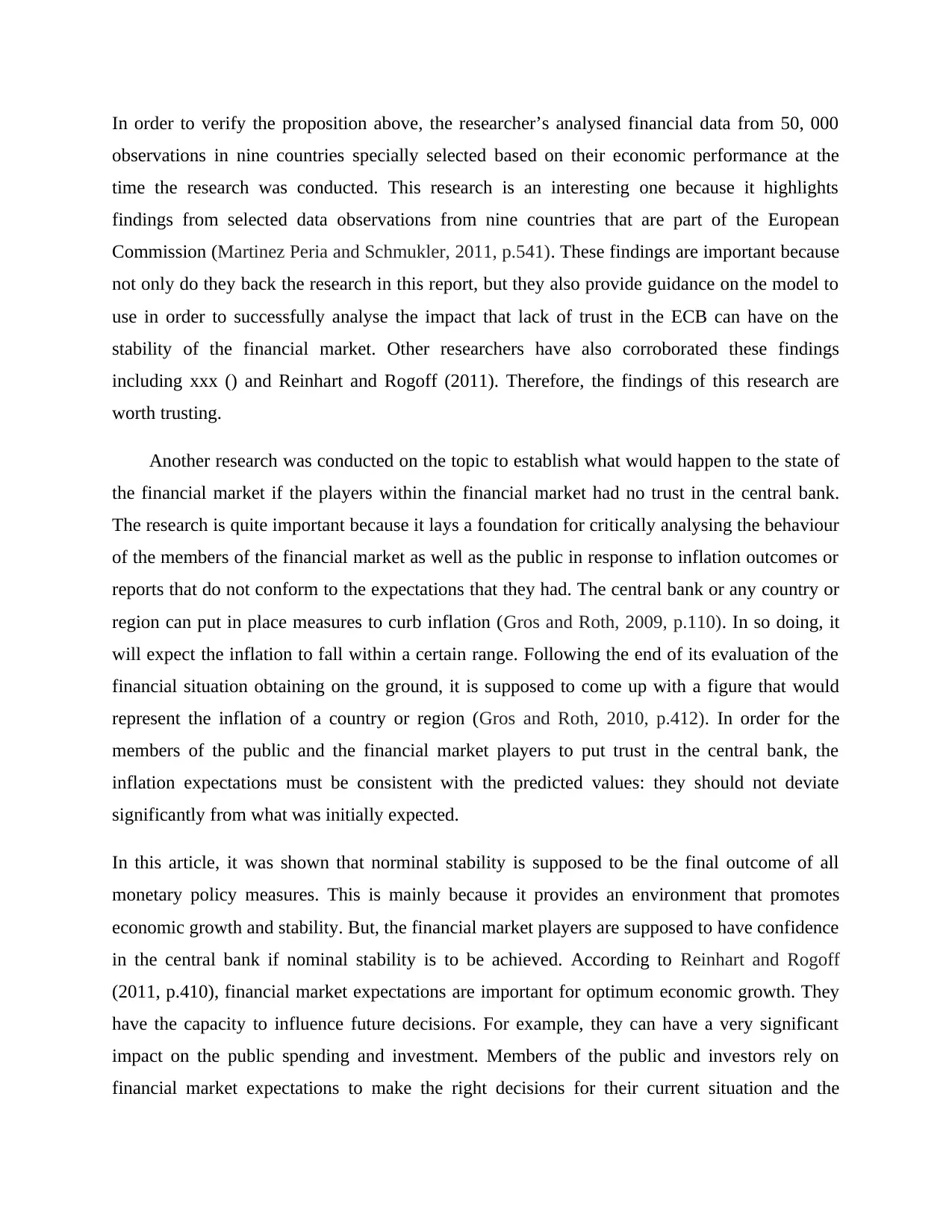
In order to verify the proposition above, the researcher’s analysed financial data from 50, 000
observations in nine countries specially selected based on their economic performance at the
time the research was conducted. This research is an interesting one because it highlights
findings from selected data observations from nine countries that are part of the European
Commission (Martinez Peria and Schmukler, 2011, p.541). These findings are important because
not only do they back the research in this report, but they also provide guidance on the model to
use in order to successfully analyse the impact that lack of trust in the ECB can have on the
stability of the financial market. Other researchers have also corroborated these findings
including xxx () and Reinhart and Rogoff (2011). Therefore, the findings of this research are
worth trusting.
Another research was conducted on the topic to establish what would happen to the state of
the financial market if the players within the financial market had no trust in the central bank.
The research is quite important because it lays a foundation for critically analysing the behaviour
of the members of the financial market as well as the public in response to inflation outcomes or
reports that do not conform to the expectations that they had. The central bank or any country or
region can put in place measures to curb inflation (Gros and Roth, 2009, p.110). In so doing, it
will expect the inflation to fall within a certain range. Following the end of its evaluation of the
financial situation obtaining on the ground, it is supposed to come up with a figure that would
represent the inflation of a country or region (Gros and Roth, 2010, p.412). In order for the
members of the public and the financial market players to put trust in the central bank, the
inflation expectations must be consistent with the predicted values: they should not deviate
significantly from what was initially expected.
In this article, it was shown that norminal stability is supposed to be the final outcome of all
monetary policy measures. This is mainly because it provides an environment that promotes
economic growth and stability. But, the financial market players are supposed to have confidence
in the central bank if nominal stability is to be achieved. According to Reinhart and Rogoff
(2011, p.410), financial market expectations are important for optimum economic growth. They
have the capacity to influence future decisions. For example, they can have a very significant
impact on the public spending and investment. Members of the public and investors rely on
financial market expectations to make the right decisions for their current situation and the
observations in nine countries specially selected based on their economic performance at the
time the research was conducted. This research is an interesting one because it highlights
findings from selected data observations from nine countries that are part of the European
Commission (Martinez Peria and Schmukler, 2011, p.541). These findings are important because
not only do they back the research in this report, but they also provide guidance on the model to
use in order to successfully analyse the impact that lack of trust in the ECB can have on the
stability of the financial market. Other researchers have also corroborated these findings
including xxx () and Reinhart and Rogoff (2011). Therefore, the findings of this research are
worth trusting.
Another research was conducted on the topic to establish what would happen to the state of
the financial market if the players within the financial market had no trust in the central bank.
The research is quite important because it lays a foundation for critically analysing the behaviour
of the members of the financial market as well as the public in response to inflation outcomes or
reports that do not conform to the expectations that they had. The central bank or any country or
region can put in place measures to curb inflation (Gros and Roth, 2009, p.110). In so doing, it
will expect the inflation to fall within a certain range. Following the end of its evaluation of the
financial situation obtaining on the ground, it is supposed to come up with a figure that would
represent the inflation of a country or region (Gros and Roth, 2010, p.412). In order for the
members of the public and the financial market players to put trust in the central bank, the
inflation expectations must be consistent with the predicted values: they should not deviate
significantly from what was initially expected.
In this article, it was shown that norminal stability is supposed to be the final outcome of all
monetary policy measures. This is mainly because it provides an environment that promotes
economic growth and stability. But, the financial market players are supposed to have confidence
in the central bank if nominal stability is to be achieved. According to Reinhart and Rogoff
(2011, p.410), financial market expectations are important for optimum economic growth. They
have the capacity to influence future decisions. For example, they can have a very significant
impact on the public spending and investment. Members of the public and investors rely on
financial market expectations to make the right decisions for their current situation and the
⊘ This is a preview!⊘
Do you want full access?
Subscribe today to unlock all pages.

Trusted by 1+ million students worldwide
1 out of 34
Related Documents
Your All-in-One AI-Powered Toolkit for Academic Success.
+13062052269
info@desklib.com
Available 24*7 on WhatsApp / Email
![[object Object]](/_next/static/media/star-bottom.7253800d.svg)
Unlock your academic potential
Copyright © 2020–2025 A2Z Services. All Rights Reserved. Developed and managed by ZUCOL.





